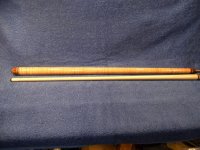I have searched and found several threads about A-joint vs full splice playability questions...
but I was just curious about a one piece of wood, full length, assuming you could find a 30" piece that is straight, do you gain or lose anything by not having a "construction" method?
but I was just curious about a one piece of wood, full length, assuming you could find a 30" piece that is straight, do you gain or lose anything by not having a "construction" method?
![20150113_125334[1].jpg](/data/attachments/272/272639-c7586ed90557bfa258e3d73c66ed7dee.jpg?hash=x1hu2QVXv6)
